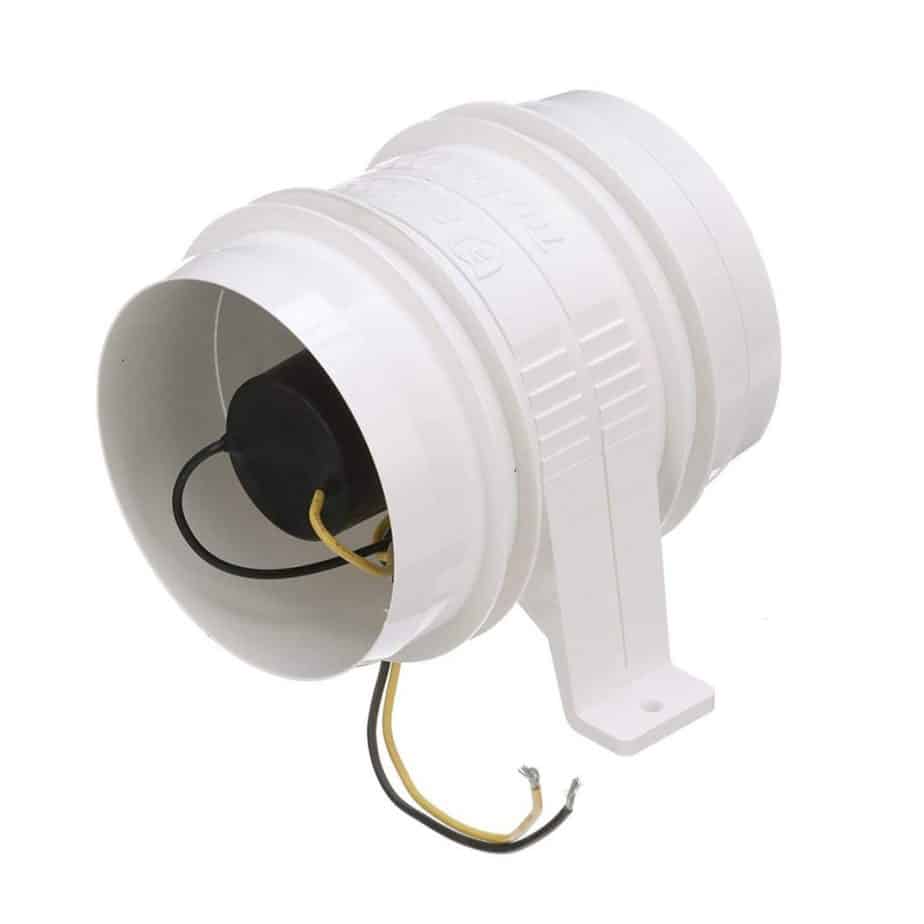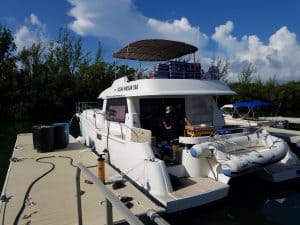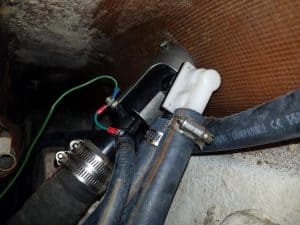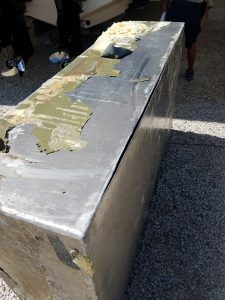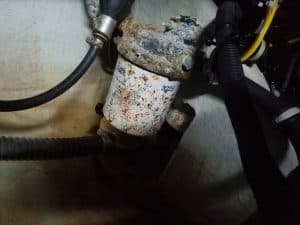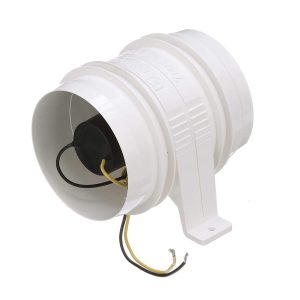If you have run a boat with an inboard engine in it, then you have probably seen a switch that says blower on it! Leaving you to wonder:
What Is A Bilge Blower On A Boat & What It’s Used For? A Bilge Blower on a boat is a fan that is used to remove flammable fumes from the engine compartment. This is to help prevent an explosion in the engine compartment whenever the engine is turned on after sitting for an extended period of time. The fumes that build-up are usually caused by a leak in a gas line or hose.
This article will teach you all about bilge blowers, what they are, how they operate, and the different styles of blowers that have been used over the years!
What Is A Bilge Blower & Where Is It Located?
Inboard engines can cause hazardous and potentially flammable gases to build up inside the engine compartment of your boat. If these gases are allowed to build up inside your boat. A tiny spark or static charge could cause an ignition, exploding your beloved boat to smithereens!
To prevent this from happening, the boats must exhaust the gases to remove the risk of explosion. For this purpose, boats utilize a device called a bilge blower.
A bilge blower (or blower motor) is a small exhaust fan that you install in the transom of your boat. Typically, you attach the blower to a hose that goes down to your inboard engine compartment. You connect the other end of the blower to a bilge vent on the outside of your boat.
The bilge blower sucks in the hazardous fumes from the engine compartment. And exhausts them out of the boat through the vent. This prevents the gas from building up in your engine room and increasing the risk of an explosion on board!
When Should A Blower Be Operated On A Boat?
Whenever you start your boat after it has been sitting idle for some time. You should turn your blower on before starting the engine. If by any chance, any flammable gases have collected inside your boat, the blower will exhaust them out.
If they have not, no harm is done. You will have an easier time starting the boat knowing that you do not run the risk of accidentally blowing it up.
Many people think it is a good idea to leave the bilge blower on while they refuel the boat. They think that turning on the blower will exhaust any gases that build up inside the bilge. However, you don’t need to do this. And really, you shouldn’t.
Turning the blower on while you are refueling does the exact opposite of what you intended it to do. Since the blower is sucking the air out of the engine compartment. The air that is inside the compartment is being replaced. With the fumes of the fuel in the air while refueling.
It’s actually more possible to be pulling in fuel fumes!
Hence, you should generally not turn your bilge blower on while you are refueling. Turn it off when refueling, then turn it on once the tank is filled. If any flammable gases made their way into the bilge. The blower will exhaust them out so you can start your boat without worrying.
Do You Leave It On or How Long To Run Blower On Boat?
Some people leave their bilge blower on all the time while they are driving their boat. This might be the best practice or the worst. Depending on the type of bilge blower you have on your boat.
Ordinary bilge blowers are not built to operate continuously. So you can burn them out! However, you should run them for at least four minutes to ventilate the bilge before starting the engine. This will rid the bilge of any gas buildup that might be present in the bilge.
Sometimes, leaving the bilge blower on for even four minutes will not clear the bilge of explosive gases. You should rely on your nose to detect whether or not there are still gases present inside the bilge.
Sniff the bilge area around the engine. If there is a strong smell of gasoline in the air. (Here’s an article that outlines exactly What You Should Do If Your Boat Smells Like Gas.)
It is a good idea to leave the blower running for a little while more. Doing so will protect your boat from damage, and might even save your life in the process.
When you spill some fuel inside the bilge, it will continue to emit flammable vapors inside the bilge. No matter how long you leave the blower on, it will still not clear the compartment of flammable gases.
In this case, you will have to clear the fuel first. After that, you should leave the bilge blower on and the compartment hatch open, long enough for the gases to escape.
Rely on your nose to determine when this happens. Once the strong odor of gasoline goes away, you can safely start your engine.
It is also a good idea to leave the blower on when you are idling or traveling at no-wake speeds for a long time.
The engine has more unburnt fuel vapors coming from the exhaust in these conditions. Which can find their way into the bilge. Turning the blower on will exhaust these vapors and keep you safe.
If you leave these ordinary blowers on for the entire time you are out on the water. They might blow out and stop functioning though. Then you will need to replace the blower before you set out on the water again!
Alternatively, you can buy a heavy-duty bilge blower that is meant to be run continuously. These blowers are obviously more expensive than ordinary blowers but might be worth the additional cost.
If you leave your bilge blower on all of the time, getting a quality heavy-duty blower is an excellent purchase decision. You would never have to worry about forgetting to turn the blower on or off during the entire ride.
Just switch it on before you start the boat, and switch it off after you turn off the engine.
Starting Boat Without Blower
If you have an inboard engine boat, a bilge blower is an absolute requirement. The United States Coast Guard (USCG) requirements include functional bilge blowers. On all non-open type boats built after 1980 that run on gas.
Even if your boat is much older than that, it must meet the minimum USCG ventilation levels. Which may require a bilge blower depending on the ventilation.
However, you should not only think of a bilge blower as a legal formality. Your life, and the life of your passengers, depends on a functional bilge blower.
Do not take this lightly – a non-functional bilge blower can cause your engine to catch on fire while you are out on the water. In extreme cases, it can even blow your boat to smithereens, taking the lives of all passengers on board.
Thus, you should never start an inboard engine boat that does not have a bilge blower. If it is absent from the boat or not working properly, get it fixed before your next trip out on the water.
But in order to start the engine without the blower, just open up the engine compartment hatch to allow it to ventilate. You’ll want to try and fan out the compartment with a towel or something.
Or if you have a fan, that would work to. The fuel fumes are heavier than the air, so fanning out any fumes if you smell fuel in the compartment, this is what the bilge blower is doing.
Boat Blower Motor Not Working?
It will take some time for the fumes to air out. But it is also important to figure out why you have the fume build up in the first place!
To troubleshoot the bilge blower and figure out why it’s not working. You will need to know some electrical basics. There are really four main things that can go bad with the blower.
The wiring, the switch, the fuse or breaker, or the bilge blower itself. You’ll want to unhook the blower and make sure it is getting power. If the blower is getting power, then you will need to get a new blower.
If it is not getting power, then you will want to check the fuse or breaker to it. Then as long as that is good. You can test the switch and then the wiring. It will be quick and easy to just follow the power from the fuse or breaker towards the blower.
Looking to see where the voltage drops off!
Then there are some people who have the idea of using some other type of air blower to ventilate the bilge. This, again, is not a good idea.
Properly designed and constructed bilge blowers have ignition protection. The electrical components on these blowers are covered with insulation to prevent sparking. Otherwise, they might just be the cause of the spark that causes the very explosion that they are trying to prevent.
If your bilge blower is not working, just get a quick fix from your local mechanic. Things will be much easier that way.
Best Inline Bilge Blower & Quiet Bilge Blower
The type of bilge blower you should go for can get a bit confusing, especially if you are unfamiliar with how they work. No need to worry, we will break it down for you.
There are two main types of bilge blowers; centrifugal and in-line.
In-line bilge blowers are much more cost-effective and draw less power from your battery to function. In most cases, installing an adequately sized in-line bilge blower is your best bet.
However, in some cases, especially when you have complicated and restrictive ducting in your ventilation system. You might need a centrifugal bilge blower instead.
This is because centrifugal blowers can create more pressure to counteract the friction that restrictive ducting can introduce in your ventilation system.
If your boat mechanic recommends that you install a centrifugal blower, you should get that. For other scenarios, installing an in-line bilge blower will work fine.
Not only will installing an in-line bilge blower lower the cost of installation and running. It will remain quieter during operation as well.
Bilge blowers can be quite noisy during operation, especially when your boat is idling. The constant noise from the motor can disrupt communication between passengers on the boat.
There is nothing like the constant purring of a motor to disturb the peace and serenity you can get out on the water.
If the constant noise of the bilge blower bothers you, buy a quiet bilge blower model instead. Our recommendation for a quiet in-line bilge blower is the Attwood 1749-4 Quiet Blower from Amazon.
With an extensive 3-year warranty covering the product, you can be confident that the blower will continue to pull its weight on the water. You can install it horizontally or vertically, depending on the ventilation system on your boat.
The pump is water-resistant, so you can ease your mind about it giving up with consecutive uses. With a clever design that maximizes airflow and efficiency. You get an extremely quiet operation, even when the engine is not running to drown out the noise.
Moreover, the Attwood features a low amperage motor that draws less current. This increases the longevity of both, your battery and your blower. If you’re looking for the best in-line quiet bilge blower, get the Attwood from Amazon.
Check Us Out!
Now that you know all about your boat’s bilge blower and how it operates. Here are some other articles from us that you will find extremely helpful and informational!
Inboard Vs. Outboard Motor: What’s Right For You?
The Advantages & Benefits Of Center Console Boats!
What Is The Best Boat To Buy For A Beginner?
If you’ve got any questions or comments, let us know by subscribing to our YouTube Channel!
And if you would like to support us to continue bringing you great content, please click the link below to Amazon where we get a commission from anything you are already going to buy!
Click Here To Amazon!
And you can also donate by clicking the donate button here or on the right hand of the screen!
It really helps us out and we thank you so much for your support!
Thanks for reading and we look forward to reading your responses and comments.
We’d also like to invite you to check out Our YouTube Channel! Where we create all kinds of How-To and DIY videos to help you learn more and more about your boat and how it works!

